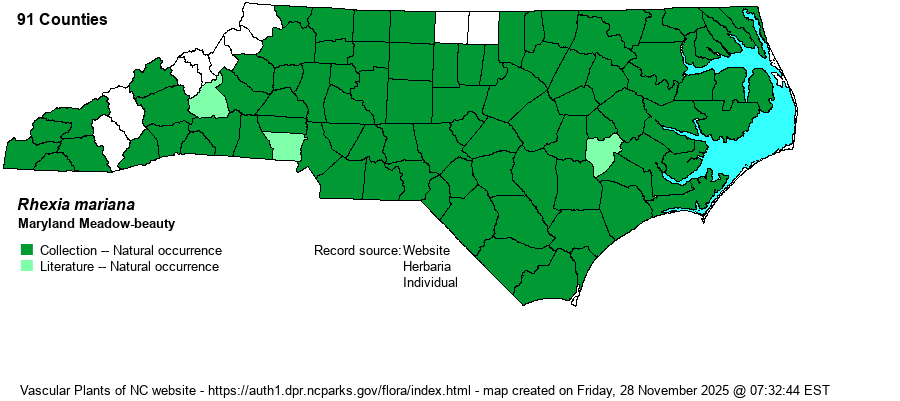| Author | L. | |
| Distribution | Ranges over all of the Coastal Plain and Piedmont; in the Mountains essentially limited to the southern half of the province. The well-marked var. exalbida, at times listed as s separate species, is limited to the Sandhills region and some counties to the east (to Wayne and Pender counties).
This is a widespread southern species, ranging from NJ and southeastern KS, south to the Gulf Coast.
| |
| Abundance | This is, by far, the most numerous species of Rhexia in the state, though it can be outnumbered in much of the Coastal Plain by R. nashii. It is common and widespread in the Coastal Plain and Piedmont, and fairly common in the southern half of the Mountains, but very rare in the northern half (recorded only from Alleghany County so far). This applies to the full species as well as to the nominate variety. The var. exalbida is common to even locally abundant in the clay-based bay region of Scotland, Hoke, and Robeson counties, and fairly common to locally common in the Sandhllls region. | |
| Habitat | The nominate variety has a wide range of wetland habitats, growing in marshes, ditches, damp or wet roadsides, damp powerline clearings, margins of bogs, and pine flatwoods, among others. However, var. exalbida is limited mostly to pools and shallow ponded waters, especially in clay-based bays; however, it also grows along marsh edges, other damp clearings, ditches, and other wet spots, usually in proximity to pines or cypresses. |
| Phenology | Blooms from May to October, with var. exalbida normally from June to September; fruits shortly after flowering. | |
| Identification | These two varieties act like different species in NC. The nominate one is mostly branched and grows to about 1 foot tall, rarely to 1.5 feet tall. It has elliptical paired leaves, often about 2 inches long and 3/4-inch wide. The flowers at the branch tips and upper axils are paler than in other species, being a medium to light pink -- never rose, and are about 1-inch across. The var. exalbida is normally unbranched, grows to about 1 foot tall and usually in very dense stands, and has very narrow, linear leaves. Its flowers are white (rarely pale pink) and about 1-inch across. You will not have any difficulty identifying var. exalbida in bloom, and normally either the nominate variety. However, you may need to check stem and capsule (hypanthium) characters to separate some of the Rhexia species away from clay-based bays and limesink ponds (such as R. nashii, R. ventricosa, and R. virginica). R. ventricosa and R. virginica have strongly squared stems at mid-stem level, with each four sides about equal, almost flat, and the angles sharp or winged. R. mariana and R. nashii have one pair of sides rounded and longer than the other pair, and thus the stem is very unsymmetrical when rotated between your fingers. Eliminate R. nashii by its hypanthium being longer, 10-15 mm (about 1/2-inch long), glabrous or glabrate, and its larger and more rosy-pink flowers, with each petal nearly 1-inch long; R. mariana has its hypanthium less than 2/5-inch long, glandular-hairy, and its petals are about 1/2-inch long and usually a paler pink in color. | |
| Taxonomic Comments | As mentioned in Distribution, there are two distinctly marked varieties of this species in NC, treated by a few references as good species, but most -- including Weakley (2018) -- consider them as varieties owing to some blending of characters in the western part of the range.
| |
| Other Common Name(s) | None | |
| State Rank | S5 | |
| Global Rank | G5 | |
| State Status | | |
| US Status | | |
| USACE-agcp | FACW link |
| USACE-emp | OBL link |

